50c notes of the Estado de Sonora
(This section is the result of research by Robert Perigoe. The information originally appeared in the March 2018 issue of the Journal of the U. S. Mexican Numismatic Association).
The 25c and 50c notes appear to have been printed together, judging by the apparent consistency in seal placements and numbering patterns. They still differ in their basic printing characteristics.
First Series
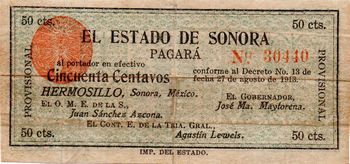
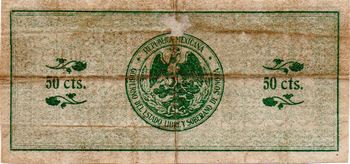
M3814a 50c El Estado de Sonora - 1st Series
Position A - Hand seal 5 - Small seal, with spot
[image needed}
Position B - Hand seal 2 - Small seal, no spot
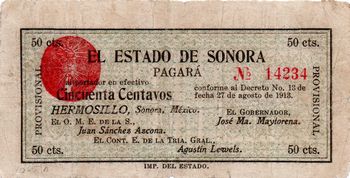
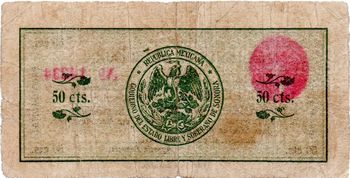
Position C - Hand seal 3 - Large, normal 'C'
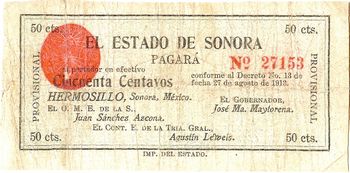
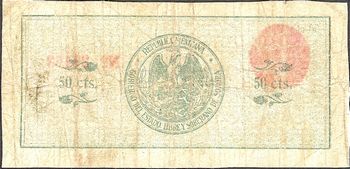 Position D - Hand seal 1 - Large, broken 'C'
Position D - Hand seal 1 - Large, broken 'C'
The identifying characteristic of the four printing positions is virtually the same as for the 25 centavos in its first series. In Position B, the uprights of the ‘P’ in ‘PAGARA’ and the ‘D’ in ‘ESTADO’ are aligned on both sides. In Position C, the diagonal stroke of the ‘R’ in Sonora does not extend below the print line whereas it does in the other positions. And only in Position D is the comma after ‘HERMOSILLO’ centred above the space to the left of the ‘S’ in ‘DE LA S.’.
Once again, the hand seals used are types 5, 2, 3, and 1, appearing in Positions A through D respectively.
On the reverse, in Position A, the eagle seal is Small – With Spot. In Position B, it is Small – No Spot. In Position C, it is Large – Normal ‘C’. In Position D, it is Large – Broken ‘C’.
Presumably, the print runs also mirror those set out for the 25 centavos note.
Second Series through the Fourth
Apparently, the final three of the four series were also produced in lockstep with those of the 25 centavos issue.
Again, the print area in these series was extended sufficiently to accommodate the series number. All of the other attributes of the 25 centavos enabling the distinction between the four print positions are shared by the 50 centavos issue, and the hand seals are located in the same way.
Second Series
There is one minor glitch in the serial numbering that shifts within the second series. For some reason, the serial numbering devices themselves became transposed after the first 8,000 notes were printed. (The change did not affect the type of number sign or hand seal used.) The sample strongly suggests that the devices moved in such a way that the top and upper middle ones appeared in the lower middle and bottom spots, and vice versa. This aberration is evidence of the fact that there may well be others, and numbering is not a reliable position indicator.
[image needed]
M3814b 50c El Estado de Sonora - 2nd Series
Position A/C - Hand seal 2 - Large, broken 'C'
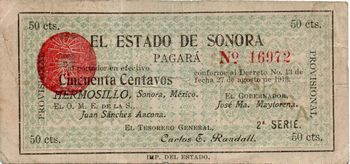
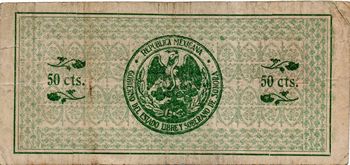
Position B/D - Hand seal 3 - Large, normal 'C'
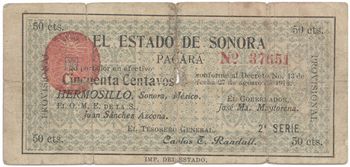
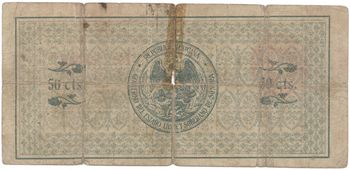
Position C/A - Hand seal 4 - Small seal, with spot
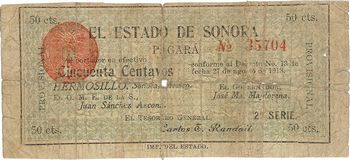

Position D/B - Hand seal 1 - Small seal, no spot
Third Series
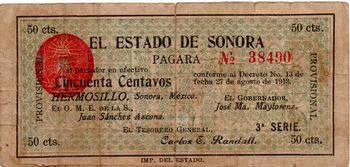
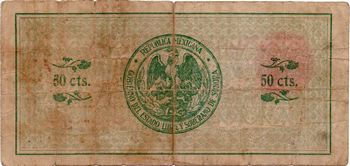
M3814c 50c El Estado de Sonora - 3rd Series
Position A - Hand seal 2 - Large, broken 'C'
[image needed]
Position B - Hand seal 3 - Large, normal 'C'
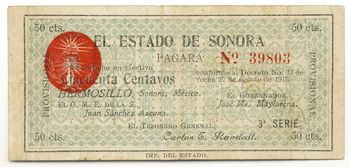
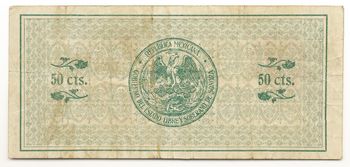
Position C - Hand seal 4 - Small seal, with spot
[image needed]
Position D - Hand seal 1- Small seal, no spot
Fourth Series
For the fourth series, the same four hand seals are used, but transposed. Types 4, 1, 2, 3 are now found in Positions A through D respectively.
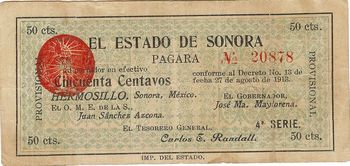
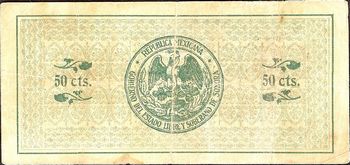
M3814d 50c El Estado de Sonora - 4th Series
Position A - Hand seal 4 - Large, broken 'C'
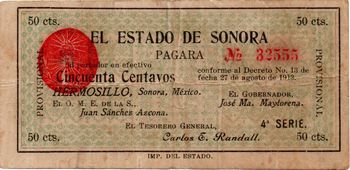
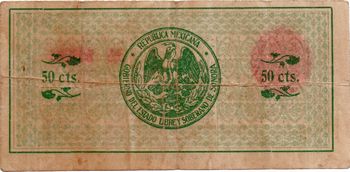
Position B - Hand seal 1 - Large, normal 'C'
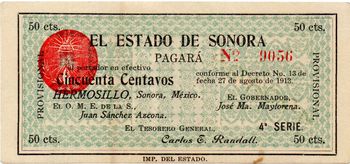
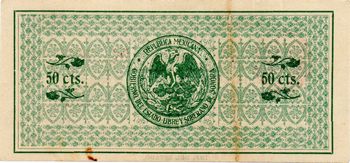
Position C - Hand seal 2 - Small seal, with spot
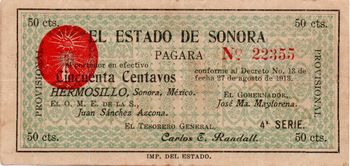

Position D - Hand seal 3 - Small seal. no spot
In summary:
| Series | Position | Hand Seal Type |
Seal on reverse |
| A | 5 | Small, with spot | |
| B | 2 | Small, no spot | |
| C | 3 | Large, normal 'C' | |
| D | 1 | Large, broken 'C' | |
| 2 | A | 2 | Large, broken 'C' |
| B | 3 | Large, normal 'C' | |
| C | 4 | Small, with spot | |
| D | 1 | Small, no spot | |
| 3 | A | 2 | Large, broken 'C' |
| B | 3 | Large, normal 'C' | |
| C | 4 | Small, with spot | |
| D | 1 | Small, no spot | |
| 4 | A | 4 | Large, broken 'C' |
| B | 1 | Large, normal 'C' | |
| C | 2 | Small, with spot | |
| D | 3 | Small, no spot |
